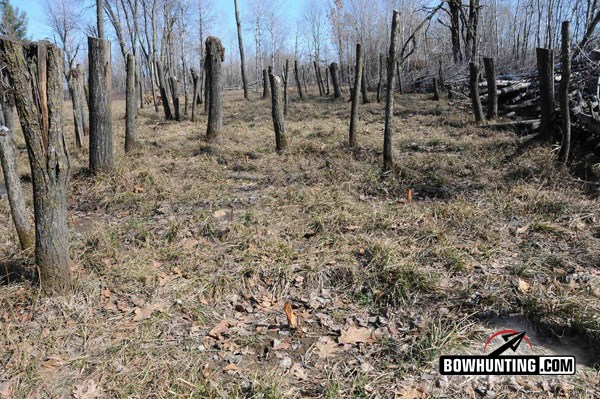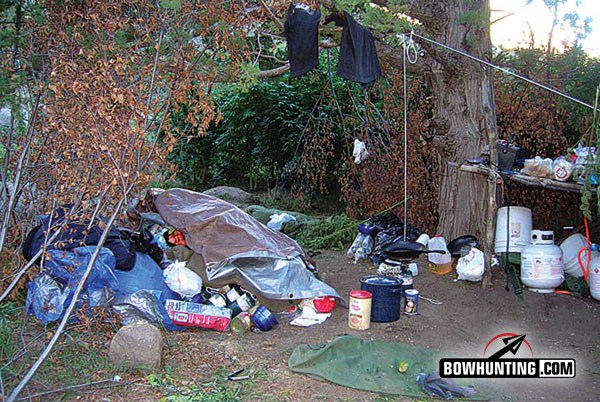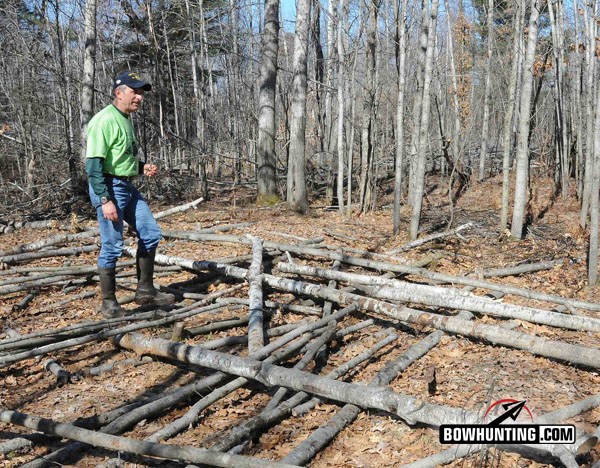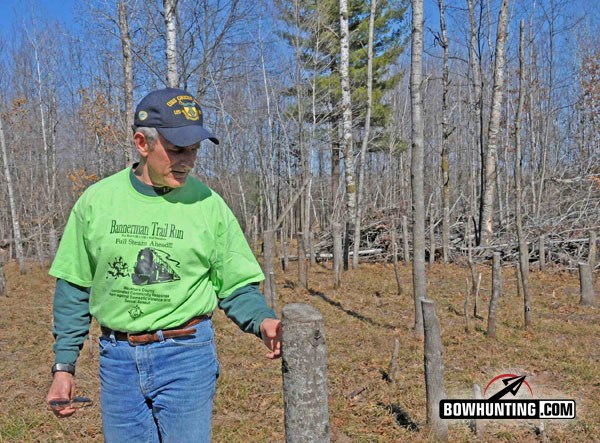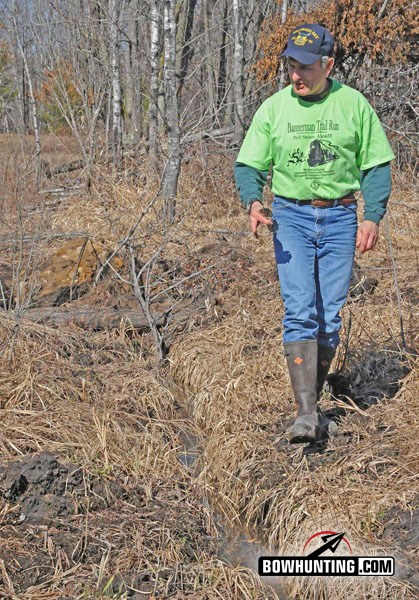LAST UPDATED: May 8th, 2015
If you’re scouting or exploring public lands for the upcoming archery season, keep your eyes open for unusual diggings, tree cuttings or ramshackle huts. You might just stumble onto an illegal marijuana farm.
That’s because Mexican-based drug cartels have been using our national forests and wildlife-management areas for large-scale marijuana gardens in recent years. These “grows” have been found from California to Ontario, Canada, and some of them are within half-miles of well-traveled roads.
These trees were cut down with handsaws to expose marijuana plants to sunlight. The small orange markers in the foreground are remnants of marijuana plants.
For example, law-enforcement agencies busted up an 8,000-plant “grow” in northeastern Wisconsin’s Navarino State Wildlife Area in 2009, and a 9,000-plant grow in 2008 farther north in the Nicolet National Forest.
In other cases, they choose remote areas accessible only by boat. In 2009, law-enforcement officers dismantled a 2,000-plant operation deep inside the swamps of Wisconsin’s fabled Buffalo County, in the Tiffany State Wildlife Area along the Mississippi River.
Officials estimate each marijuana plant, which can grow taller than 6 feet, is worth $1,000 or more on the street. If so, the combined Navarino, Nicolet and Tiffany seizures were worth $19 million.
When illegal workers are discovered at marijuana-growing sites, they usually drop what they’re doing and disappear into the woods without their belongings.
Randy Stark, chief warden for the Wisconsin Department of Natural Resources, said these marijuana operations are a national problem, with the growers using the Internet to find county, state and national public lands for their operations. To deter those responsible, agencies are working with other states and federal law-enforcement organizations, as well as the U.S. Forest Service and Bureau of Land Management.
A recent BLM report said Mexican drug traffickers have expanded marijuana cultivation in the United States since 2004. As the U.S. government increased its efforts to stop smuggling and illegal immigration along the U.S./Mexico border, cartels found it easier to grow marijuana on our public lands than to smuggle large quantities across the border.
Between 2004 and 2008, the BLM alone seized 1.79 million marijuana plants on lands it administers, with seizures more than doubling from 220,000 plants in 2004 to 473,771 in 2008.
A Wisconsin DNR staffer involved in the Navarino cleanup and investigation said cartels plant marijuana strains designed for the North’s short growing season. In fact, Canadian officials have found marijuana operations in public forests of northwestern Ontario.
These logs were used to build a tarp-covered shelter at the main camp of a marijuana operation in Wisconsin’s Navarino Wildlife Area.
The staffer, who couldn’t reveal his identity for security reasons, said the cartels look for low-lying public lands far from homes and buildings, with good water sources for irrigating the plants. He said the groups are sophisticated, and probably study satellite images to find ideal growing sites. They usually key on stands of young aspen (poplar), which is also ideal habitat for deer, woodcock and ruffed grouse.
He said the workers are usually illegal immigrants who are coerced to help. Typically, the operations begin in late May with work crews dropped off late at night with a camp boss, food, equipment and thousands of young marijuana plants growing inside small cups, like those used to start tomato plants.
From there, they haul their gear at least a half-mile into thick cover and set up a campsite beneath the woods’ canopy, taking care to avoid service roads, dikes and trails. Officials estimate the Navarino operation required 20 to 30 illegal workers, who lived in shelters built with plastic tarps stretched across log frameworks.
To make freshly cut trees difficult to spot from airplanes, marijuana growers rub mud on the stumps.
The crews live in such sites for four months, and can’t leave until the crop is harvested in fall. They’re resupplied periodically at night along drop-sites on isolated roads.
The workers use handsaws to quietly clear each growing site, cutting trees waist-high and then smearing stumps with mud to make them less visible from the air. They haul the felled trees to the clearings’ edge and stack them side by side like a palisades. They also dig deep holes for refrigerating perishables, as well as small canals and “silencer pits” to muffle the sounds of gasoline-powered generators and irrigation pumps.
The marijuana gardens aren’t far from the central camp, which sits like a hub between them. The hub is about the only area where workers leave trails. When approaching roads and other areas where anglers, hikers and picnickers might wander, the workers seldom follow the same path twice.
Why do they use public lands? Few people visit the interiors of large public lands during summer because they’re usually swarming with ticks, black flies, deer flies and mosquitoes. Therefore, it’s rare for visitors to spot such setups.
The Wisconsin DNR staffer said abandoned camps are littered with empty cans, jugs and bottles that once held beer, water, bug spray, hand-wash and deer repellant for the marijuana plants. (Whitetails heavily browse the leaves of untreated “pot” plants.) When cleaning the Navarino camp, workers also found bones from poached deer.
Workers dug this irrigation trench with hand tools to water their marijuana plants.
When hunters, hikers or other recreationists stumble onto such sites, the workers usually just drift into the woods, never to return. They’re long gone when authorities arrive.
Warden Stark warns hikers, hunters, campers, anglers and berry pickers to stay alert if spotting unusual activity on public lands this summer and fall. “Walk out the same way you walked in,” Stark said. “If possible, get the GPS coordinates, and contact someone in law-enforcement as soon as possible.”
Stark said workers at these sites usually avoid confrontations, but some carry weapons. In addition, marijuana operations are sometimes booby-trapped.
“We don’t want to scare people and make them think our public lands are unsafe, but we want everyone to be aware and stay alert,” Stark said. “We need their help to shut down these operations. The people doing this need to realize these are public lands and they’re not welcome here.”

 By
By 